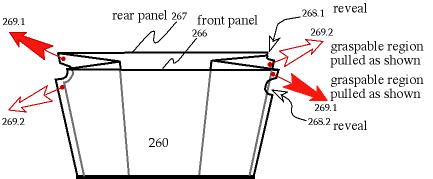AUTOpack™:
a machine-handleable bag for automated packing
Potatoes,
carrots, grapes, radishes, and other agricultural products ...
as well as industrial products like washers, candies, pumbling
parts, repair
kits, bolts,
equipment
parts,
bulk salt, sugar, or fertiliser etc., confectionery, spices ...
anything that is bagged is a target for AUTOpack™.
AUTOpack™
can extend the reach of automated packaging because it inherently
supports a simple and potentially small and inexpensive system
that would be tolerant of workflow variations and interruptions.
AUTOpack™
is a new approach in machine-handleable bags, for fully automated
bulk packaging and for smaller applications like agricultural/produce
packaging (carrots, potatoes, radishes, apples...) and a range
of industrial and commercial packaging (and potentially in-store
checkout bagging).
AUTOpack™ will
compete with the two main automated bagging technologies:
form-fill-seal bags, with 'preopened' asymmetrical bags.
(Don't forget that much bagging is still done with the ordinary
tedious purely hand-operated
bag.) Because of AUTOpack's™ flexibility, economy,
and the simplicity of the machinery that will handle it,
it has the potential to change the way certain types of industrial
and agricultural packaging is done. For example, this technology
is inherently less expensive and more portable than existing
bagging technologies, so one can imagine individual farms
or groups
of them owning
their own machinery that is portable and goes right to the
field if necessary, or adapted onto harvesters, as well as
used in the barn. The
technology is also inherently tolerant of variations in processing
speed,
and outright stoppages, without waste. It is thus suitable
for "when ready" cycle completion.
Attention
engineering and machinery companies: we are seeking
partnerships for the bag-handling
machinery.
We
envisage
a substantial
market,
ranging from short-run agricultural packaging, through
light commercial (kits, confectionery, parts packaging),
potentially all the
way to enhanced checkout stations that present an opened
bag for ready for filling by checkout staff or customers.
There is scope for your engineering expertise to result
in patents that build your company, consolidate your strategic
position, and expand your markets. Please contact us for
discussions.
|

A
bag that can be opened reliably by a machine
~ for filling stations that are semi/completely mechanised ~
Until
now --- the problem with getting a machine to open a bag
is that
the machine would have to work like people do, and sense
that it had gripped one layer (not two). That would require
more perception
and precision than is practically available in machines. SNAP™ solves
this problem by drastically reducing the requirement
for perception and precision. The cutouts in alternate pleats
of the bag make it possible for a low-precision machine to
grasp each of the four 'corners' of a bag, open it, and hold
the bag open. |
Suitable
for an automated bagging station, AUTOpack™ is
a bag that can be handled and fully opened by a machine. The bags
would be on a roll fed from the bottom (from top is possible but
requires an extra step in handling). The bags shown are 'flat-top',
but they could have handles (like T-shirt bags, or as punch-outs).
If bottom-feed,
the bag could be filled before or after detaching from succeeding
bag; filled bags would be then either left attached (giving strips
of filled bags, workable if contents are light and not too bulky)
or could of course be detached.
If top-feed, the bag has to be fully separated from the succeeding
bag before filling.
Each bag has
four easily-accessible grasping points so that they can be fully
and positively opened by machines. Each grasping point is immediately
accessible without the need for rubber fingers etc. to separate
layers.
How would the
bagging machinery work?
The handling
machine grips are to be aligned with the bag's grasping points.
Even if the film is very clingy the bag will still be openable
because the grip and action are so positive. The anticipated application
would see these handled on rolls for feed into filling machines.
Bag feed could be upward or downward. The fingers grasping the
pair of tabs corresponding to the back of the bag would often be
rigged to remain stationary, while the 'front' fingers would move
in unison, pulling the front away (or first to one side to break
the interlayer cling, and then away to fully open the bag mouth,
a kind of zigzag motion). Many forms of actuation
are possible, many kinds of fingers, etc., so, as said above, there's
plenty of scope for innovation beyond the basic principles laid
out here.
Bagging machines
could range from semi-automatic to fully automatic.
Semi-automatic:
manually activated once per bag. E.g., as the operator has completed
filling one bag, s/he can trigger a switch) to close and detach
the filled bag while a new bag is advanced, opened, and presented
for filling. Operator can pause any time without causing a foulup
and waste of empty but sealed bags, etc. That is not the case with
form-fill-sea bagging. That means AUTOpack is much more
suited to small-scale and short-run packaging than competing form-fill-seal
bags.
Fully automatic:
the filling operation can be automated and can trigger presentation
of a bag and removal and sealing once it is filled. If there is
a power failure, there is no need for a warm-up time before restarting
as with form-fill-seal baggers, and no waste of material or need
to clear out melted film or malformed bags caused by the interruption.
With Autopack, the bags are already made.
AUTOpack means
that a regular but intermittent user can afford a simple machine
and a supply of custom-printed bags that previously would have
been impractical for small users.
Applications:
... automated
bagging for short-run tasks that require flexibility. E.g. 40 tons
of carrots/onions/marbles/washers etc. in bags (4 oz to 40 gallon,
etc.), bags to be machine-opened, filled, machine-closed (weld,
tie, staple, tape, etc.), & the next bag to be advanced and
opened, etc.
back
to top
|